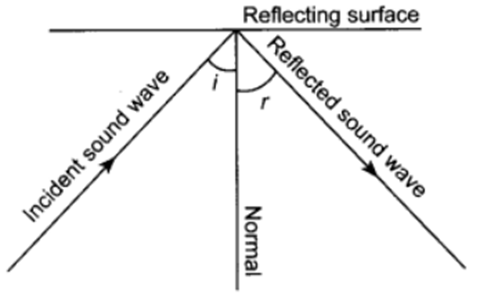Laws of reflection
• The incident sound wave, the reflected sound wave and the normal, all lie in the same plane.
• The angle of incident of incident sound wave is equal to the angle of reflection formed by the reflected sound wave, that is, i = r

Echo
• When we hear the same sound again and again in a medium it is called Echo.
• The sound or echo persists in our brain for 0.1 seconds. This means that the difference between sound and its echo should be at least 0.1 seconds.
• It is produced as a result of reflection of sound through a medium. If sound reflects more than once we may hear multiple echoes.
Reverberation: Repeated reflections of sound results in persistence of sound and is called reverberation.
Use of Reverberation of Sound: Following instruments use this property of sound:
1. Megaphones, Shehanais, Trumpets
2. Stethoscope
3. Curved dome of concert halls
Advantages of Multiple Reflection of Sound
• Horns, trumpets, loudhailers or megaphones are designed in such a way that sound can travel in a particular direction only without spreading out everywhere. This makes it easier for the audience to listen to the speaker. All these instruments work on the phenomena of multiple reflections of sound.
• The multiple reflections in a stethoscope tube make it possible for the doctors to listen to a patient’s heartbeat.
• Concert halls are generally covered so that sound can reflect through it and reach the wider audience.
• Human auditory range is between 20 Hz and 20000 Hz.

 Science Made Easy
Science Made Easy
